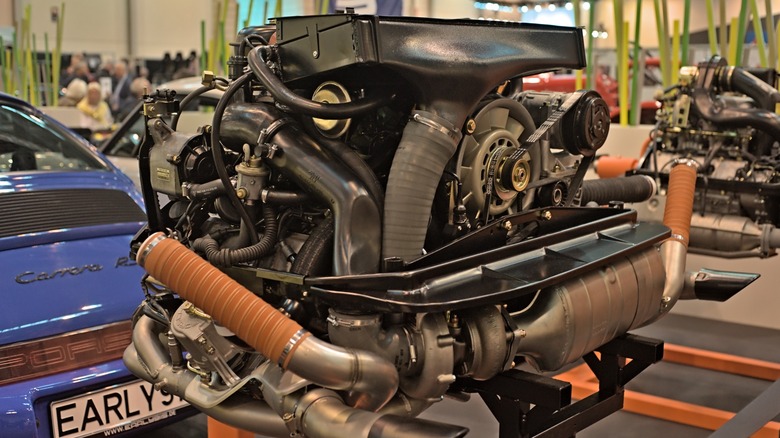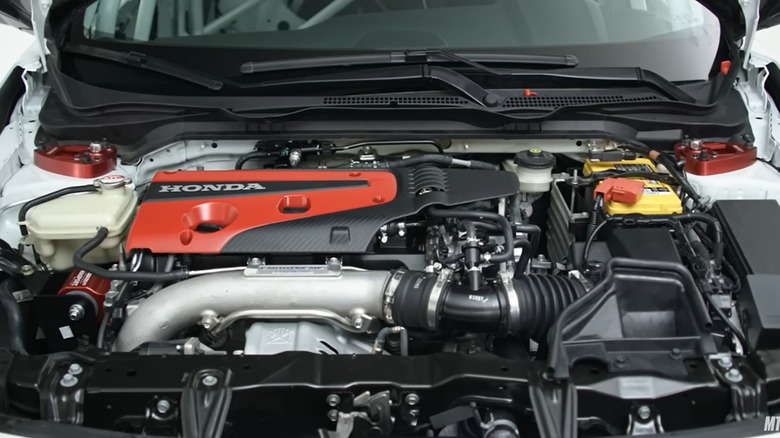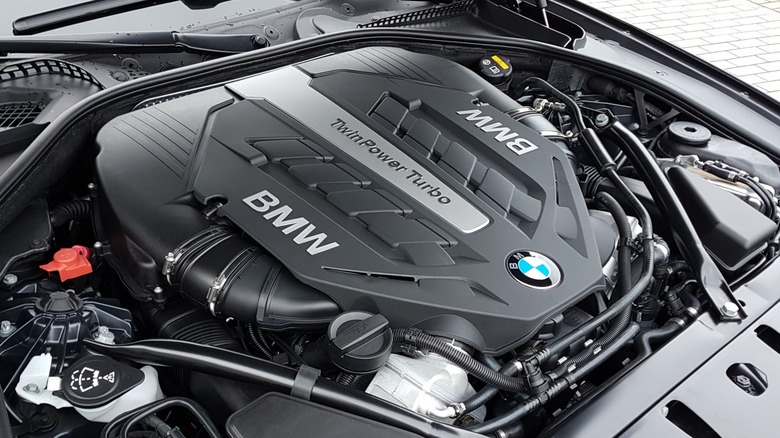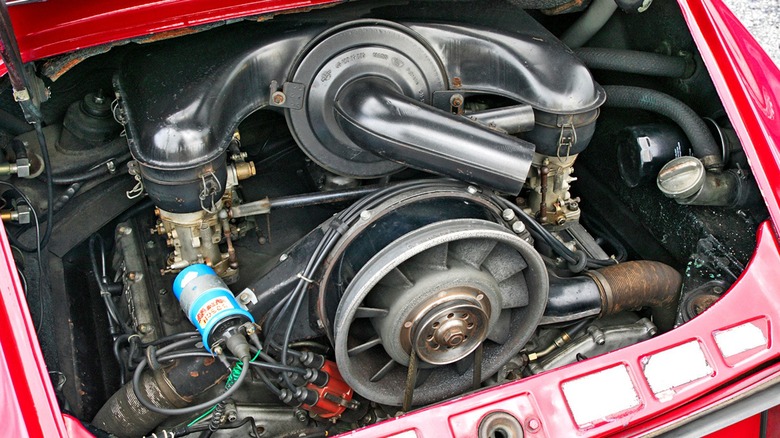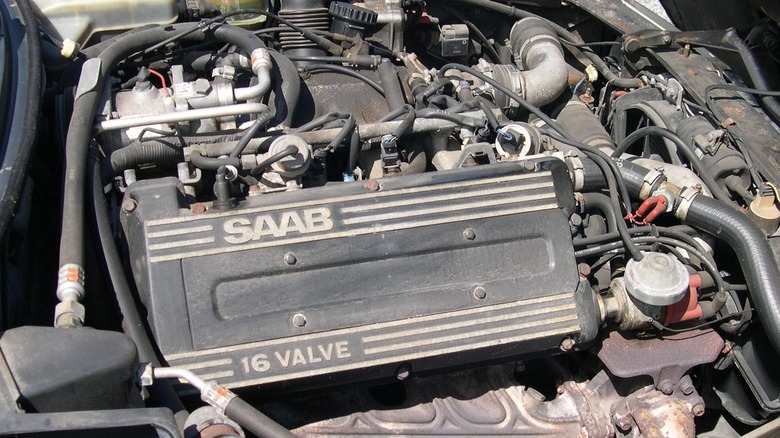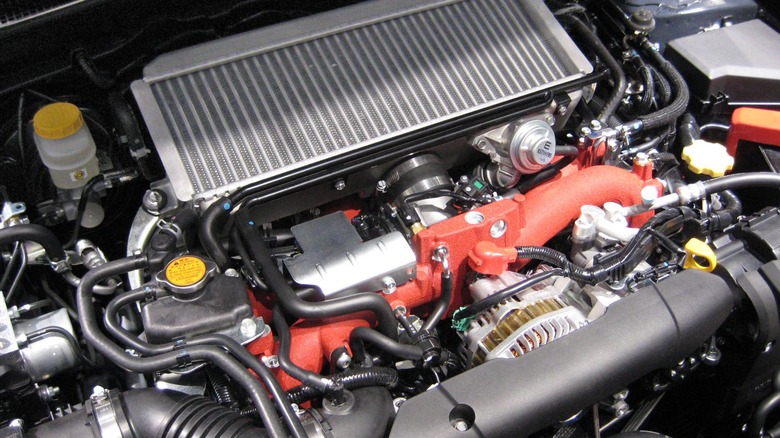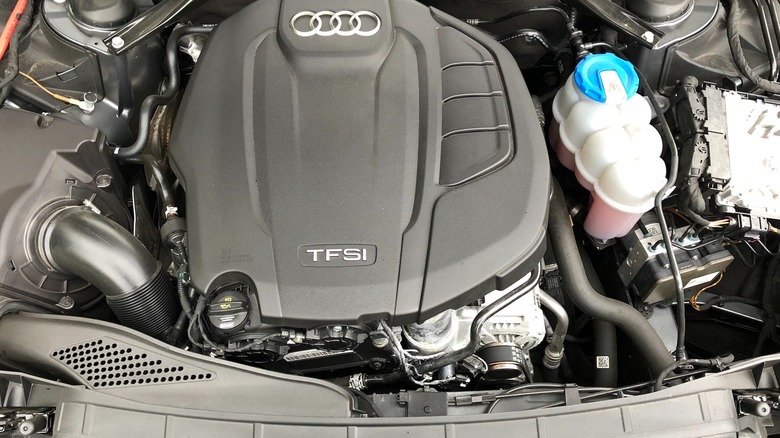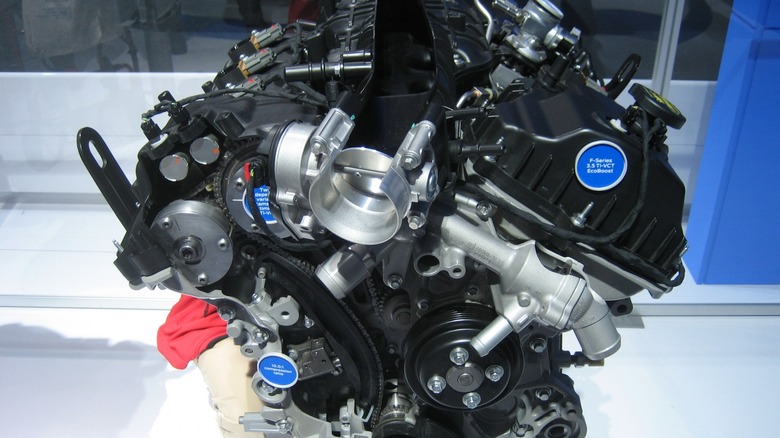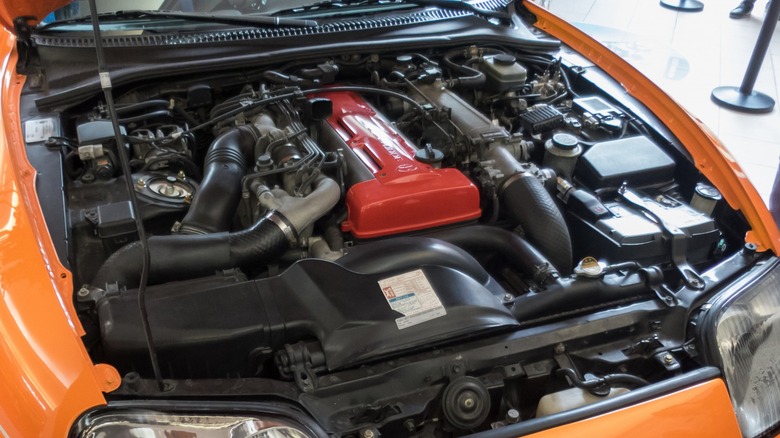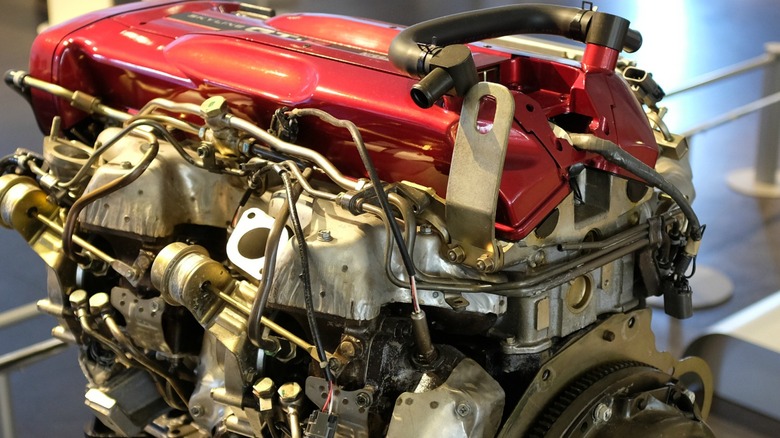10 Of The Most Reliable Turbocharged Engines Ever Built
The advent of turbochargers on road cars began in the mid-1960s, during the muscle car era when the phrase "there is no replacement for displacement" meant more power output was best achieved with higher displacement engines. However, turbocharged engines demonstrated that in many cases, more power could be accomplished with a smaller displacement, while fuel efficiency is improved, and exhaust emissions are reduced.
In simple terms, a turbocharger supplies air under high pressure and density with a high concentration of oxygen to the engine for a more complete combustion process and increased power. A turbo uses exhaust gas that drives a turbine fan on one side of the turbocharger. On the other side, connected by a shaft, another fan or compressor draws in fresh air, pressurizes it, and forces it into the engine. The turbo boost applied to the engine is measured by the difference between the high-pressure air and the atmospheric pressure.
Proper maintenance is mandatory for turbocharged engines. The average well-maintained turbo can last up to 150,000 miles. Still, some may reach up to 200,000 miles, and modern turbocharged engines with technological improvements tend to be more reliable than older models.
Here are 10 of the most reliable turbocharged engines ever built.
[Featured image by Thomas Vogt via Wikimedia Commons | Cropped and scaled | CC BY-SA 2.0]
Honda Turbocharged 2.0-Liter K20C1 4-cylinder
In 2015, Honda first introduced the 2.0 VTEC turbocharged inline four-cylinder engine in the Civic Type R, and two years later a less powerful version in the Honda Accord. The lightweight engine is made with a die-cast aluminum open-deck cylinder block fitted with cast iron cylinder sleeves. Main bearings with reinforced caps hold a lightweight forged steel crankshaft with micro-polished journals for friction reduction in place.
Inside the engine block, there is a lightweight forged steel crankshaft with micro-polished journals for friction reduction. Other weight-reducing internals include lightweight pistons with cavity-shaped crowns and a low-friction molybdenum coating pushed by heat-forged high-strength steel connecting rods. The turbocharged 2.0-liter also has a cylinder head made of aluminum connected to water-cooled exhaust ports that reduce exhaust gas temperatures. The engine also features Honda's VTC (Variable Valve Timing Control) and i-VTEC (Variable Valve Timing and Lift Electronic Control) which adjusts exhaust valve lift, timing, and duration to reduce turbo lag.
The K20C1 version installed in the MK5 Civic Type-R produced 306 horsepower at 6,500 rpm and 295 lb-ft of torque at 2,500 rpm. Although the K20C1 engine has some potential problems, its reliability is exceptional. The Honda four-cylinder has been awarded "moon mile" status, meaning it is reliable enough to reach the moon and beyond (NASA says the moon maintains an average distance of 238,855 miles from Earth). According to the Precision Turbo Services website, with proper maintenance, the K20C1 can reach 150,000 miles or more.
BMW Twin-Turbo 4.4-Liter S63 V8
In 2011, BMW introduced the S63 high-performance engine, replacing the N63 to power the 2010 E70 X5M and E71 X6M models. BMW made a few fundamental changes to the N63 engine including an upgrade from standard turbos to twin-scroll turbos with a pulse-tuned exhaust manifold. The high-performance turbos are made with two exhaust gas inlet chambers driving different parts of the turbine. The design spins up the turbos faster, providing a maximum boost of 17 pounds per square inch (psi), 50 percent higher than the N63.
The 4.4-liter twin-turbo V-8 mated to a seven-speed automatic, or six-speed manual, produced 560 horsepower. The new engine not only generated more power, but also corrected most of the mechanical problems that occurred with the N63, making it one of the most reliable turbocharged engines ever. One owner stated: "The s63 is extremely reliable. I've had three vehicles with this platform. They don't grenade unless you tune to unreasonable torque and/or run really high boost with pump gas."
The S63 featured the innovative "hot-vee" V8 engine design with the turbocharger and exhaust manifolds positioned in the valley formed by the cylinders. The configuration shortened the path of hot air going from the tailpipe to the turbochargers, keeping the components cooler and speeding up the spooling process (less turbo lag). BMW installed the S63 only in the top tier of its M lineup, including the X5 M, X6 M, M5, M6, and M8. It was the automaker's most powerful engine and the 2022 version in the BMW M5 CS produced 635 horsepower and 553 lb-ft of torque.
[Featured image by Dr.DOHC/Wikimedia Commons via Wikimedia Commons | Cropped and scaled | CC BY-SA 4.0]
Audi Turbocharged 2.5-liter TFSI five-cylinder
The Audi 2.5-liter TFSI (Turbo fuel stratified injection) five-cylinder engine is an advanced and reliable engine. Audi built the engine with high-quality materials and components made to withstand extreme driving conditions and high-power output tuning. The Audi 2.5-liter TFSI has consistently won the International Engine of the Year Award for the best engine in the 2-to-2.5-liter category.
Several engine features distinguish it from the competition. The compact and lightweight design weighs only 160 k. Built with an aluminum block, the engine fits a variety of Audi engine bays. The DOHC valve control with four valves per cylinder uses Audi's valve lift system (AVS) for variable valve lift adjustment, which is fuel efficient and contributes to higher performance. Direct fuel injection technology creates a more efficient combustion process with a higher compression ratio, improving fuel economy, reducing emissions, and augmenting power output. The 2.5-liter TFSI five-cylinder has a turbocharger with exhaust air cooling at a pressure of 2.35 bar (34 psi) which promotes maximum airflow and minimum throttling loss.
In the 2022 Audi RS 3, with all-wheel drive and a seven-speed auto-shift manual transmission, the 2.5-liter I-5 engine produced 401 hp at 6,500 rpm and 369 lb-ft of torque at 3,500 rpm. Car and Driver accelerated their 3639-pound RS 3 from 0 to 60 mph in a mere 3.3 seconds, reaching the quarter mile in 11.8 seconds at 117 mph, and achieving a top speed of 159 mph.
Porsche Twin-Turbo 3.7-Liter Flat-Six
Most car buyers know that Porsche is a German car brand well-known for producing high-tech, high-performance sports cars. Today, Porsche builds six different models, each with several versions: the Porsche 911, 718, Cayenne, Panamera, Macan, and Taycan. The automaker is also well-known for its durable and reliable vehicles that will last for years. Even the Porsche 911, built for speed and hard driving, boasts significant longevity. Porsche claims that roughly two-thirds of the company's sports cars still exist today, and that thanks to the Porche Classic, around 150,000 vehicles of the 911 model range alone are still being driven today."
In 2022, for the second year in a row, JD Power designated the Porche 911 as the "best car for hassle-free ownership," while the Cayenne won the reliability award in the Upper-Midsized high-end SUV category. Much of the car's reliability can be attributed to the engines. Proper maintenance is a key factor (as it is in all vehicles) in engine durability. Well-maintained 911s have proven to run over a hundred thousand miles without problems, but most will last over 150,000 miles.
Porsche equipped the 2022 Porsche 911 Turbo and Turbo S with the twin-turbo 3.7-liter flat-six that develops 572 hp in the Turbo and 640 hp in the Turbo S. The engine helped rank the 2022 Porsche 911 in the top five of JD Power's premium brands measured, ranking higher than much of the competition including BMW, Mercedes-Benz, Audi, Acura, and Jaguar.
[Featured image by GFDL via Wikimedia Commons | Cropped and scaled | GNU Free Documentation License]
Saab Turbocharged 2.0-Liter B202 4-cylinder
Few, if any, automakers can claim their products are "Born from Jets" as Saab did to promote its cars leveraging its aircraft heritage. The slogan was successful and the traditional builder of sturdy and dependable front-wheel-drive Swedish cars became all the rage with the young generation when it launched the Saab 900 Turbo three-door.
In 1984, Saab introduced the B202 engine that would set the standard for modern turbocharged engines. According to saabplanet.com, Saab's B202 engine is among the longest-lasting performance four-cylinders in history. While the engine is prone to normal head gasket failure, the bottom end of the engine has demonstrated reliable operation for up to a million miles with only regular maintenance.
The 2.0-liter turbocharged and intercooled B202I featured fuel injection and a 16-valve cylinder head with double overhead camshafts and hydraulic valve lifters. An electronic engine management system composed of a combination of the new Bosch LH-Jetronic and the Saab APC-system with knock regulation controlled the fuel supply operation. The power output of the B202 varied according to the model, but the maximum power was from 160 horsepower to 185 horsepower, and the maximum torque varied from 188 lb-ft to 200 lb-ft.
"Solid, reliable vehicle," one 1990 Saab 900 XS owner stated. "I have had this Saab for about [eight] years now having had a Saab before this one. The car has been very reliable and has done 237,000 plus miles on the same engine."
[Featured image by Sfoskett via Wikimedia Commons | Cropped and scaled | GNU Free Documentation License]
Subaru EJ20 Turbo
Subaru established a reputation for manufacturing reliable naturally aspirated four-cylinder engines with their EJ20 line, the EJ20E being the most famous engine of the range. Although the early versions (late 1990s through about 2007) of the EJ20 engine experienced head gasket failures that risked severe damage, Subaru corrected the problem, and the more modern engines have become reliable, with a life expectancy of several hundred thousand miles.
In 1989, Subaru introduced the automaker's first high-performance engine with the quad-cam EJ20 turbo, first appearing in the Legacy RS/GT. The Subaru Legacy Wagon 2.0-liter GT Turbo four-cylinder featured four valves per cylinder, double overhead camshaft valve gear and produced 197 hp at 6000 rpm and 190 lb-ft of torque at 3600 rpm. Power was sent through a 4-speed automatic gearbox to the front wheels. In 1992, Subaru also equipped the GC/GF-series Impreza WRX with the EJ20 turbo engine.
The EJ20 turbo used Subaru's horizontally opposed engine architecture, which eliminates the need for a power-consuming balance shaft. The turbo version introduced the use of a lightweight aluminum crankcase and heads. The two-liter displacement was achieved with oversquare 92-millimeter bore and 75-millimeter stroke dimensions, resulting in a higher redline, top-end torque, and horsepower at a high rpm. A multi-point fuel injection system, coil-on-plug ignition, and knock sensing also contributed to performance. The Subaru 2.5-liter engine, in both the naturally aspirated and turbocharged versions, has proven to be powerful and reliable, making them a good value. Subaru employed the engines across a wide range of models and all of them have numerous reports from high-mileage owners.
[Featured image by Hatsukari715 via Wikimedia Commons | Cropped and scaled | Public Domain]
Volkswagen Turbocharged 2.0-Liter EA888 4-cylinder
Volkswagen designed and built the turbocharged 2.0-liter EA888 engine for durability and reliability. The automaker used only the highest-quality materials and components to resist extreme stress levels experienced during hard driving. The engine is also fitted with reinforced cylinder heads, forged connecting rods, and high-strength crankshafts. Introduced in 2004, the engine has undergone several improvements and upgrades over time and has become one of the most reliable and versatile engines on the international market.
Volkswagen was a pioneer in the development of turbocharging technology and the fruition of the automaker's efforts may best be represented by the EA888 engine under the hood of a 2022 Golf GTI and Golf R. One of the most advanced Volkswagen engines ever built, the 2.0-liter four-cylinder produces 241 horsepower while delivering 34 mpg on the highway in the Golf GTI and 315 horsepower with an EPA-estimated 30 mpg in the Golf R.
The EA888 engine employs chain-driven double overhead camshafts that support four valves per cylinder and provide longevity and reliability. Continuous variable valve timing and valve lift ensure rapid spent gas evacuation permitting the turbocharger to spool quickly resulting in rapid torque delivery across a very wide rpm range. Although early turbocharged engines developed a reputation for being unreliable, modern turbos have benefited from advances in engineering and manufacturing, making them much less likely to fail. The EA888 utilizes a unique exhaust manifold design for better thermal management of the exhaust stream and a special high-temperature resistant turbocharger to maximize efficiency and deliver maximum boost.
[Featured image by Mindax25 via Wikimedia Commons | Cropped and scaled | CC BY-SA 4.0]
Ford Twin-Turbocharged 3.5-liter EcoBoost V6
The Ford twin-turbocharged EcoBoost 3.5-liter V6 engine is the most versatile engine within the Ford lineup, used to power midsize and full-size cars, pickup trucks, SUVs, utility vehicles, and even supercars. Introduced in the 2010 Lincoln MKS, it was developed from the Ford Duratec 35 V6 engine and features a dual overhead cam (DOHC) design in a V configuration. For truck applications (like the F-150 pickup), Ford fits the EcoBoost 3.5-liter V6 with a pair of BorgWarner K03 turbochargers that spin up to 17,000 rpm and generate up to 15 psi of boost. However, the transverse-mounted engine of the Ford Taurus utilizes a pair of Garrett GT1549L turbochargers providing a maximum boost of 11 psi.
Ford made a significant upgrade to the EcoBoost 3.5-liter V6 in 2015. The automaker added port fuel injection, and electronically actuated wastegates for the turbochargers. Electronic wastegates can be independently controlled for maximum flexibility and are considered superior to pneumatic versions that rely on mechanical air pressure from the engine to actuate the turbo "door." The new turbos were also re-engineered with lighter wheels and sharper vane angles for better response and a 2.5 psi increase in boost.
Ford resolved most of the 3.5-liter EcoBoost reliability issues experienced in the first generation (2010 to 2017). The second generation is now a reliable engine that balances power with torque and efficiency. According to motorreviewer.com, "the Ford 3.5 twin-turbo V6s have good longevity and last up to 200,000 miles or beyond if owners precisely follow the maintenance schedule, use the recommended oil, and nip problems in the bud."
[Featured image by Dana60Cummins via Wikimedia Commons | Cropped and scaled | Public Domain]
Toyota Twin-Turbo 3.0-Liter 2JZ-GTE 6-cylinder
The Supra is a superstar in the Toyota lineup of performance and highly reliable cars, due in large part to the superior performance of the 2JZ-GTE inline-six engine. The factory-supplied dual sequential turbochargers help the 3.0-liter six-cylinder produce 320 horsepower and 315 lb-ft of torque. Per the website, MotorReviewer, "2JZs are famous for incredible durability. The 2JZ engine can reach a 300k mileage mark easily with proper maintenance and quality engine oil and filters."
In engineering, there are always trade-offs between product design features, and no product can have unlimited durability, infinite sustainabilty, one hundred percent efficiency, and a low cost. In mechanical engineering, a lighter structure usually causes a loss in stiffness, and an accurate mechanism becomes less efficient. When Toyota designed the 2JZ engine the engineers gave priority to durability and reliability. The design is a closed-deck engine with extra strong cylinders that can handle extreme turbo boost. A forged steel crankshaft adds additional strength and a girdle at the bottom of the engine adds rigidity. Furthermore, a three-layer steel head gasket stands up to high boost pressure without failing.
However, as reliable as the stock 2JZ engine is, it's in the aftermarket that the car proved its worth when custom tuning generated far more than 320 horsepower, but with some unavoidable drop-off in reliability. A conservatively tuned engine with the right modifications can convert a Supra into a supercar producing over 1,000 horsepower. A modified 2JZ-GTE has already generated more than 2,000 hp but with a higher risk of failure.
[Featured image by Poudou99 via Wikimedia Commons | Cropped and scaled | CC BY-SA 4.0]
Nissan RB26DETT
Manufactured between 1985 and 2004, the RB26DETT provides significant competition for the Toyota 2JZ-GTE. Both powerful inline-6 powerplants became legendary as reliable engines in road cars, on both the race track and drag strip. The Nissan R32 GT-R equipped with the RB26 officially generated 276 hp and 260 lb-ft of torque for road cars, but more likely made over 300 horsepower sending power to an all-wheel drive system.
Although the early versions of the RB26DETT engine consumed more oil than the average and the oil pumps tended to fail at high rpm, the new engines became well-known as both durable and reliable. CarThrottle called the legendary twin-turbocharged RB26DETT straight-six an "all-time great" engine. While the RB26 design was a tempting tuning platform in the aftermarket, poor implementation occasionally degraded its reliability.
The 2.6-liter inline-six RB26DETT is made with a strong, cast-iron closed deck ensuring the cylinders do not distort like they tend to in an open-deck design. The engine has an over-square rotating assembly with an 86mm bore that is larger than the 73.7-millimeter stroke. The configuration results in a higher redline, top-end torque, and horsepower at the expense of low-end torque. A ridged crank girdle prevents crank walk and keeps the crankshaft stable, while individual oil sprayers keep the pistons well-lubricated and help with cooling. The cylinder head is made of aluminum and features an intake manifold with six individual throttle bodies, to improve throttle response. The twenty-four-valve design promotes an efficient fuel/air mixture for better performance in this turbocharged engine.
[Featured image by RocketJohn via Wikimedia Commons | Cropped and scaled | CC BY-SA 4.0]
